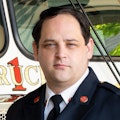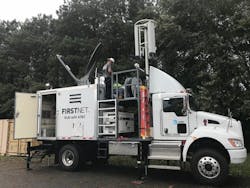Fire Tech Brief: 4 FirstNet Resources For Fire/Rescue Departments
Key Takeaways
- Among the available FirstNet resources are a truck-mounted LTE base station ideal for major disasters and a drone-based LTE antenna for hard-to-reach terrain and canopy coverage
- Requests for FirstNet resources can be made via phone or the FirstNet Central app
- Resouces are available for major emergencies and planned events
FirstNet has delivered an incredible ecosystem of technologies and systems, but the average fire/rescue department is barely scratching the surface of making use of what has been created for them. As a standard awareness, most fire departments that I have spoken to understand the FirstNet priority network access and maybe know there are FirstNet devices and apps.
Surprisingly, for major disasters or even planned events, most fire chiefs are unaware of the broad range of deployable devices available to purchase and, in most cases, borrow from FirstNet. Let us explore the world of FirstNet deployable assets and, if you do not have the connections mentioned in the article, this can serve as a starting place to get your department upgraded.
Available FirstNet resources
The first step of this journey is to know what tools can and should be added to the proverbial toolbox. We are going to explore four options: SatCOLT, miniCRD, Flying COW, and CRD/COW, along with thier coverage limits, and time for deployment.
Satellite Cell on Light Truck (SatCOLT) - The first deployable is best used for regional natural disasters, major incident scenes, and when there is a significant loss of commercial cell network infrastructure. It is a truck-mounted LTE base station/antenna with satellite uplink. It requires significant power to deploy which can be through an onboard generator or shoreline. Depending on the terrain and weather conditions it has a coverage radius of approximately two to five miles. Deployment of this resource takes as little as an hour but up to two hours. The most expensive option, coming in at $500,000 to $1,000,000 plus $35,000 to $75,000 annual reoccurring costs makes it worth being apart of the FirstNet community to get it for free.
Mini Compact Rapid Deployable (miniCRD) - For something easier to carry and deploy, consider this next option which is the size of a suitcase and can be carried in most command vehicles. The miniCRD includes a satellite antenna, FirstNet LTE modem, WI-FI, and a power source. The power source can be an internal battery, external power connection, or even solar power. Again, depending on the terrain and weather conditions it has a coverage radius of one-half to two miles. Best used for wildland crews, rural incidents, remote search and rescue incidents, and special event coverages this is the primary option that is within a department’s price range and can be deployed in less than fifteen minutes. Ownership costs are around $35,000 with plans costing varying based on satellite costs.
Flying Cell on Wings (Flying COW) - While not as robust, crews are finding themselves deployed to some extremely challenging terrain with essentially no infrastructure. This option is a drone mounted LTE antenna that can operate for up to 24 hours on a tethered drone. It works well in hard-to access areas such as canyons or for mountain rescue/wildland fire incidents and primarily elevates a cell signal above the tree canopy or damaged structures (approximately four hundred feet) and can provide a coverage radius of two to five miles. This is another option that is within a standard department budget to acquire but it may require and can be rapidly deployed in less than thirty minutes. These are currently not available for department purchase but cost nothing through emergency FirstNet deployments.
Compact Rapid Deployable/Cell on Wheels - This final option comes in both truck and trailer mounted options and boasts a telescopic tower, generally thirty to sixty feet tall. It needs a significant power source which could be an onboard generator or shore power and can support satellite, microwave, and fiber connections. This option can support hundreds of concurrent users with voice and data and is mobile. This works well for major fires (especially if cell towers are impacted), rural areas with weak coverage, overloaded networks during major regional incidents, long term incident command posts, and multi-agency coordination zones. Deploying in 30 to 90 minutes, the added cell tower can increase the coverage area in flat urban terrain (10-plus miles) but for rugged terrain or denser areas it can reasonably broadcast two to five miles. The cost is under $100,000.
How to access FirstNet Resources
The path to accessing these essential resources is straight forward. The first step is one that most departments have already completed, by contacting your FirstNet sales rep (not just the AT&T person who got all your firefighters new phones) or visit FirstNet.com to provide proof of eligibility. Your agency needs a FirstNet primary point of contact (administrator) which can be the chief, a command staff member, or communications team leader.
For planned events you should request a deployable 30 to 60 days before the event and as soon as possible for unplanned incidents. You can make the request by calling the 24/7 FirstNet Customer Operations Center at 1-800-574-7000, or through the FirstNet Central portal app. For both options be prepared to provide key incident details such as location, size, expected duration, and agencies involved.
The next step can be completed in as little as an hour depending on the resources requested, issues encountered getting to your location, and the readiness of your state’s inventory. Luckily, you do not need to become a telecommunications expert as these requested resources will be set up and operated by certified FirstNet personnel.
The last step is documenting usage for an after-action review. FirstNet wants to know how it was used, obtain crew feedback on performance, and fully understand if it met the needs. All this feedback helps FirstNet refine future deployments and can even improve your normal service.
Grant funding available
Hopefully by this point you realize you can request any of these resources for free if you are a FirstNet eligible however, there are departments that could benefit from purchasing their own. With the hefty price tags, it is best to include examples where loss of connectivity had poor outcomes, include regional partners, provide FirstNet letters of support and quotes, develop regional interoperability plans, and highlight FCC mandates or NIST guidance on resilient communications. The grant funding sources include the FEMA Assistance to Firefighters Grant, State Homeland Security Programs, Urban Area Security Initiative, Byrne Justice Assistance Grant, or Community Project Funding.
Conclusion
A lesson learned early in my career was to add as many tools to the toolbox as possible. Whether physical tools, training, or knowledge, the more diverse the toolbox the better prepared you will be for major emergencies. This quick guide is meant to give you the cliff note version to fast track your department to take full advantage of the federally funded FirstNet program. Remember, it is more than a smart phone with preferred connectivity, it is a true ecosystem of products, apps, and capabilities to improve emergency communications!
About the Author

Jason Moore
Jason Moore is a 23-year veteran of the fire service who began his career with the U.S. Air Force as a fire protection specialist. Moore is involved with the International Association of Fire Chiefs’ Technology Council and is a founding member/associate director of the Indiana University Crisis Technologies Innovation Lab. He delivered presentations on implementing technology, using technology for community risk reduction and best practices to justify funding for innovative programs. Moore was the keynote speaker at FireFusion 2024.
